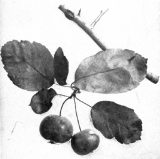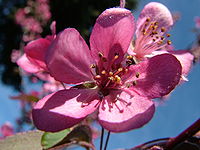
Malus coronaria
Encyclopedia
Malus coronaria, also known by the names sweet crabapple or garland crab, is a North American species
of Malus
(crabapple). It often is a bushy shrub with rigid, contorted branches, but frequently becomes a small tree with a broad open head. It prefers rich moist soil and is most abundant east of the Mississippi River. It reaches its greatest size in the valleys of the lower Ohio basin. Its flowering time is about two weeks later than that of the domestic apple, and its fragrant fruit clings to the branches on clustered stems long after the leaves have fallen.
Malus coronaria var. dasycalyx

, who was one of the twelve men whom Linnaeus called his apostles and sent forth to explore the vegetable world, wrote from America:
Species
In biology, a species is one of the basic units of biological classification and a taxonomic rank. A species is often defined as a group of organisms capable of interbreeding and producing fertile offspring. While in many cases this definition is adequate, more precise or differing measures are...
of Malus
Malus
Malus , the apples, are a genus of about 30–35 species of small deciduous trees or shrubs in the family Rosaceae. Other studies go as far as 55 species including the domesticated Orchard Apple, or Table apple as it was formerly called...
(crabapple). It often is a bushy shrub with rigid, contorted branches, but frequently becomes a small tree with a broad open head. It prefers rich moist soil and is most abundant east of the Mississippi River. It reaches its greatest size in the valleys of the lower Ohio basin. Its flowering time is about two weeks later than that of the domestic apple, and its fragrant fruit clings to the branches on clustered stems long after the leaves have fallen.
Subspecies
Malus coronaria var. coronariaMalus coronaria var. dasycalyx
- list source :
Description
- Bark: Reddish brown, longitudinally fissured, with surface separating in narrow scales. Branchlets at first coated with thick white tomentum, later they become smooth reddish brown; they develop in their second year long, spur-like branches and sometimes absolute thorns an inch or more in length.
- Wood: Reddish brown, sapwood yellow; heavy, close-grained, not strong. Used for the handles of tools and small domestic articles. Sp. gr., 0.7048; weight of cu. ft., 43.92.
- Winter buds: Bright red, obtuse, minute. Inner scales grow with the growing shoot, become half an inch long and bright red before they fall.
- Leaves: Alternate, simple, ovate, three to four inches long, one and one-half to two inches broad, obtuse, subcordate or acute at base, incisely serrate, often three-lobed on vigorous shoots, acute at apex. Feather-veined, midrib and primary veins grooved above, prominent beneath. They come out of the bud involute, red bronze, tomentose and downy; when full grown are bright dark green above, paler beneath. In autumn they turn yellow. Petioles slender, long, often with two dark glands near the middle. Stipules filiform, half an inch long, early deciduous.
- Flowers: May, June, when leaves are nearly grown. Perfect, rose-colored, fragrant, one and one-half inch to two inches across. Borne in five or six-flowered umbels on slender pedicels.
- Calyx: Urn-shaped, downy or tomentose, five-lobed; lobes slender, acute, persistent, imbricate in bud.
- Corolla: Petals five, rose colored, ob ovate, rounded above, with long narrow claws, undulate or crenelate at margin, inserted on the calyx tube, imbricate in bud.

- Stamens: Ten to twenty, inserted on the calyx tube, shorter than the petals; filaments by a partial twist forming a tube narrowed in the middle and enlarged above; anthers introrse, two-celled; cells opening longitudinally.
- Pistil: Of five carpels inserted in the bottom of the calyx tube and united into an inferior ovary; styles five; stigma capitate; ovules two in each cell.
- Fruit: Pome or apple ripening in October. Depressed-globular, an inch to an inch and a half in diameter, crowned with calyx lobes and remnant of filaments; yellow green, delightfully fragrant, surface sometimes waxy. Flesh white, delicate and charged with marlic acid. Seeds two or, by abortion, one in each cell, chestnut brown shining; cotyledons fleshy.
History
Pehr KalmPehr Kalm
Pehr Kalm was a Swedish-Finnish explorer, botanist, naturalist, and agricultural economist. He was one of most important apostles of Carl Linnaeus...
, who was one of the twelve men whom Linnaeus called his apostles and sent forth to explore the vegetable world, wrote from America:

